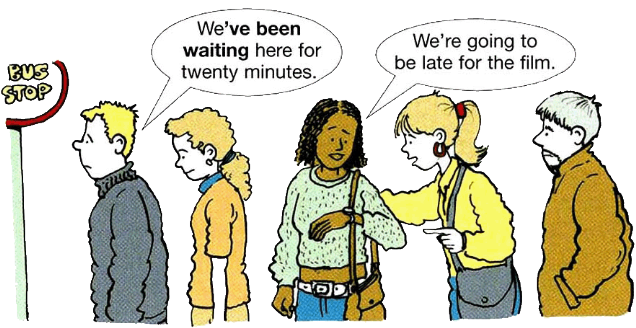The Present Perfect Continuous is a verb tense used to express a continuing activity in the past that still influences the present moment. But unlike Present Perfect, it puts the focus on the duration of the activity, not the result.



The Present Perfect Continuous expresses an activity that started in the past, is still in progress now, and might continue in the future. It is used to show that an activity in the past was in progress.
Here’s a depiction of what Present Perfect Continuous means:



This activity might just have stopped or might still be happening:
- I have been painting the house all day. I am exhausted. (past activity affects the present moment)
- He’s been fixing his car. He’s covered in oil. (while fixing is still taking place)
How to form Present Perfect Continuous
To make the Present Perfect Continuous, use:
have/has + been + the ‘-ing’ form of the verb (Present Participle)
| Note: To form the Present Participle we add ‘-ing’ to the base form of the verb. For spelling rules when adding ‘-ing’, see our article on participles. |
| Singular | Plural |
| I have (I’ve) been skating You have been skating He/she/it has been skating | We have been skating You have been skating They have been skating |
- I’ve been cooking this evening. Now I have to do the dishes.
- Jane’s been running her first marathon today, and she is very happy with her net time.
When to use Present Perfect Continuous
The Present Perfect Continuous is used to convey the following meanings.
Unfinished actions – activity
We use Present Perfect Continuous to show that something started in the past and has continued up until now. The focus is on the activity. We often use this with ‘for‘ and ‘since‘.
- We’ve been waiting for the bus for hours.
- They have been travelling since last October.
Temporary habits or situations
We can use Present Perfect Continuous to show an action that started in the past and continues to the present, but without stating ‘how long‘ so clearly. Instead, we use a word like ‘recently‘.
- I’ve been going to the gym a lot recently.
- They’ve been living with his parents while they look for a house.
Recent finished actions – result
We use Present Perfect Continuous tense to talk about action that started in the past and stopped recently. There is usually a result now.
- She has been cooking since last night. (= and the food on the table looks delicious)
- It’s been raining. (= and the streets are still wet)
Non-continuous verbs
It is important to remember that non-continuous verbs cannot be used in any continuous tenses. Instead of using Present Perfect Continuous, we must use Present Perfect.
- Sam has had his car for two years.
- NOT:
Samhas been havinghis car for two years.
Watch this video from Anglo-Link for some useful tips on using Present Perfect Continuous:
More on Present Perfect Continuous:
Present Perfect Continuous: Negative & Questions